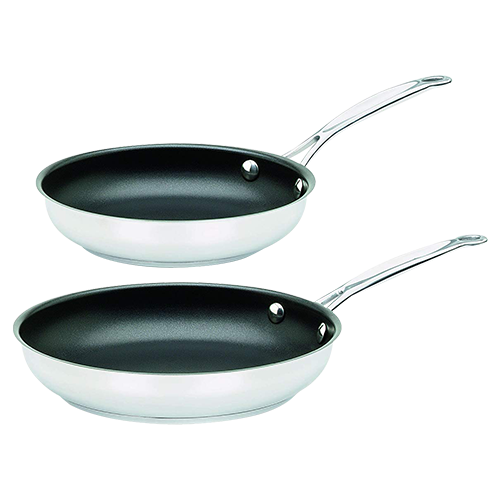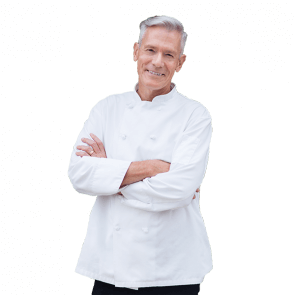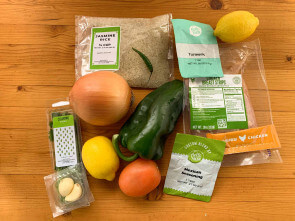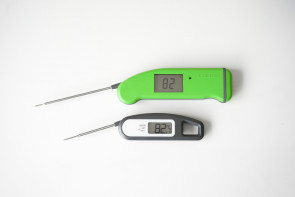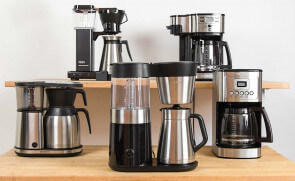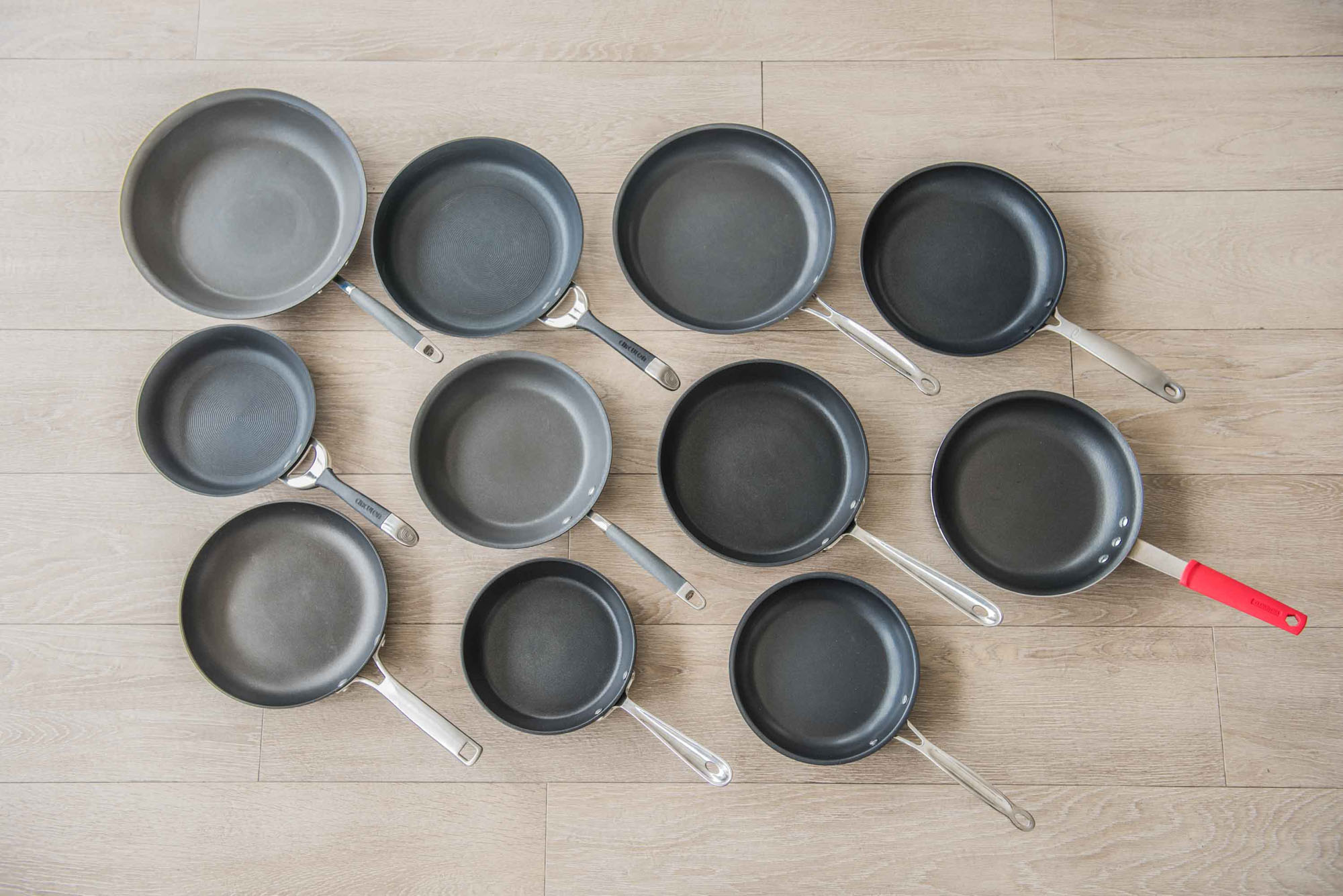
The Best Nonstick Pans
We cooked and flipped dozens of eggs and flapjacks to test seven highly rated contenders, and the Analon – 82074 Advanced French skillet was clearly the best nonstick fry pan. It’s truly 100-percent nonstick, cooks food evenly and quickly and is a cinch to clean in seconds. The best nonstick pan set is the Cuisinart – Chef’s Classic. All tough-sticking food instantly releases with a couple shakes of the pan. The two-pan set is well priced, and its mirror-glaze finish makes it beautiful to look at as well.
We cooked and flipped dozens of eggs and flapjacks to test seven highly rated contenders, and the Analon – 82074 Advanced French skillet was clearly the best nonstick fry pan. It’s truly 100-percent nonstick, cooks food evenly and quickly and is a cinch to clean in seconds. The best nonstick pan set is the Cuisinart – Chef’s Classic. All tough-sticking food instantly releases with a couple shakes of the pan. The two-pan set is well priced, and its mirror-glaze finish makes it beautiful to look at as well.
Table of contents
- Compare the best nonstick pans
- 1. Best nonstick pan: Anolon – Advanced
- 2. Best nonstick set: Cuisinart – Chef’s Classic
- Other finalists we tested
- How we selected finalists to test
- How we tested
- Who needs a nonstick pan?
- What is nonstick coating?
- Important features to consider
- The bottom line
Compare the best nonstick pans
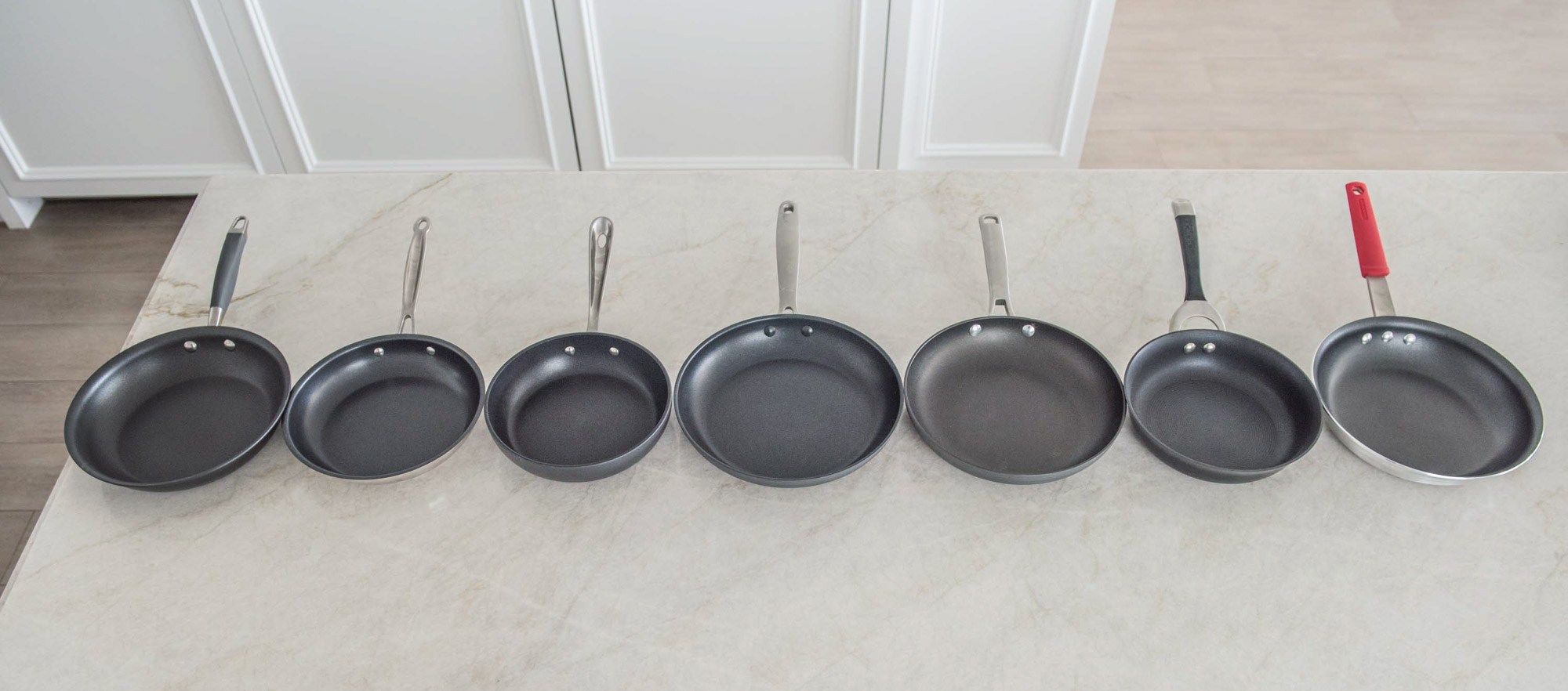
| Product | Price | Set | Weight | Nonstick Performance |
|---|---|---|---|---|
| 1. Analon - Advanced | $$ | Yes | 1.87 lb (10-inch) 2.59 lb (12.5-inch) | ☆☆☆☆☆ |
| 2. Cuisinart - Chef's Classic | $$ | Yes | 1.64 lb (9-inch) 2.16 lb (11-inch) | ☆☆☆☆☆ |
| 3. All Clad - E785S264 | $$$ | Yes | 1.97 lb (10-inch) | ☆☆☆☆ |
| 4. OXO Good Grips - Nonstick Pro | $$$ | No | 1.94 lb (10-inch) | ☆☆☆☆ |
| 5. Calphalon - 1943286 | $$$ | No | 1.76 lb (10-inch) | ☆☆☆ |
| 7. Circulon - Symmetry | $$$ | Yes | 1.83 lb (9-inch) 2.32 lb (11-inch) | ☆☆☆ |
| 6. Tramontina - 80114/535DS | $ | No | 2.02 lb (10-inch) | ☆☆ |
1. Best nonstick pan: Anolon – Advanced
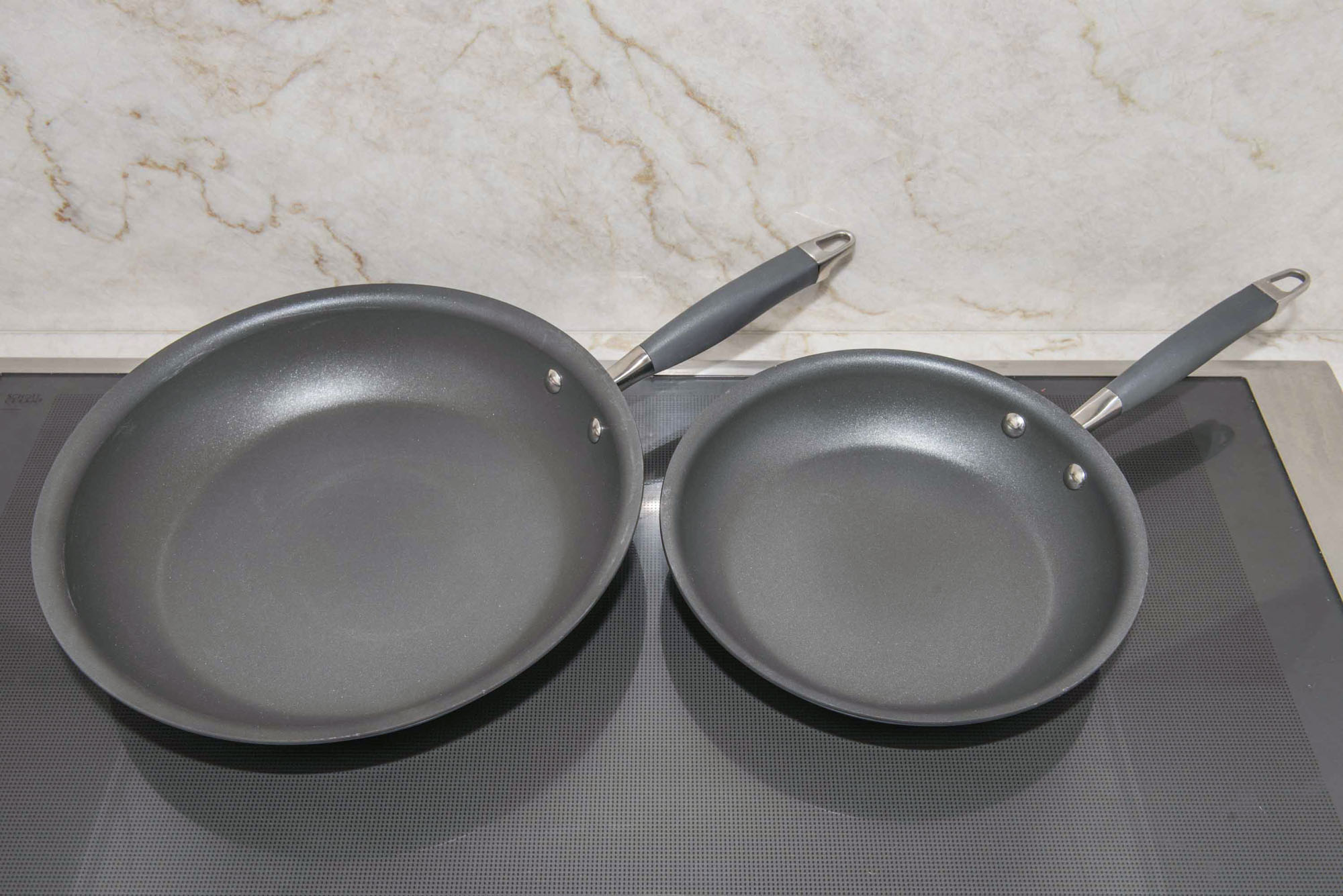
We found cooking with the Anolon – 82074 Advanced a pleasure. It’s 100-percent nonstick, and the 10-inch skillet was one of the lightest that we tested, so flipping eggs and pancakes was as effortless as Julia Child made it look.
The Anolon – Advanced is composed of anodized aluminum, which means it’s been manufactured with an electrochemical process that hardens the aluminum and makes it extra durable. It’s triple-coated with Autograph 2, a top-of-the-line Teflon derivative from Dupont’s spin-off company Chemours.
The Anolon has low sides and a smooth, flat surface, so it sat completely flat on our cooktop. It has excellent conductivity and was one of the fastest of the pans to heat up — in a mere 15 seconds — at medium-low. Hovering our hands over the pan, we could feel the heat radiating upward over the entire pan.
We cracked the eggs in the center and side, and both cooked at exactly the same rate. Thanks to the Anolon’s entirely flat surface, the eggs didn’t move, giving us the ideal bulls-eye shape. We turned the eggs over, and when the yolk was cooked (in about five seconds), we gently shook the pan, and the egg easily slid onto a plate in a compact package.
Everything cooked in a flash. Scrambled eggs came together in about 30 seconds and slid off onto the plate. Pancakes were golden brown in seconds. Again, we simply shook the pan, and the pancakes released. The sole filet was perfect: lightly browned, and since none of it stuck to the pan, we could lift and serve the filet intact.
The 8-inch handle is covered in silicone, which is easy to grip, and protects your hand from the pan’s intense heat. The Anolon was ridiculously easy to clean; once it had cooled, we simply wiped it with a paper towel in between tests and washed it with a damp sponge when we were done.
The 10-inch skillet is sold separately and as a set with a 12-inch skillet. The larger pan performed exactly the same, but because its handle is too short, we found it less easy to maneuver on and off the stove top.
However, it’s actually much cheaper to buy the set than it is to buy the 10-inch skillet separately. Because of the larger pan’s slight design flaw, we can’t recommend the Anolon as a set. But the 10-inch skillet outperformed all other finalists, and so, by itself, the Anolon 10-inch skillet is the best nonstick pan.
Key takeaways:
- The Anolon – 82074 Advanced 10-inch French skillet has a smooth, flat surface with three coats of high-end nonstick coating that makes it truly 100-percent nonstick.
- With a simple shake of the pan, everything we cooked slid right out and onto a plate.
- The Anolon has superb conductivity and heat distribution and cooked the fastest and most evenly of all the nonstick pans we tested.
- With a simple wipe of a paper towel or damp sponge, the Anolon is a cinch to clean.
2. Best nonstick set: Cuisinart – Chef’s Classic
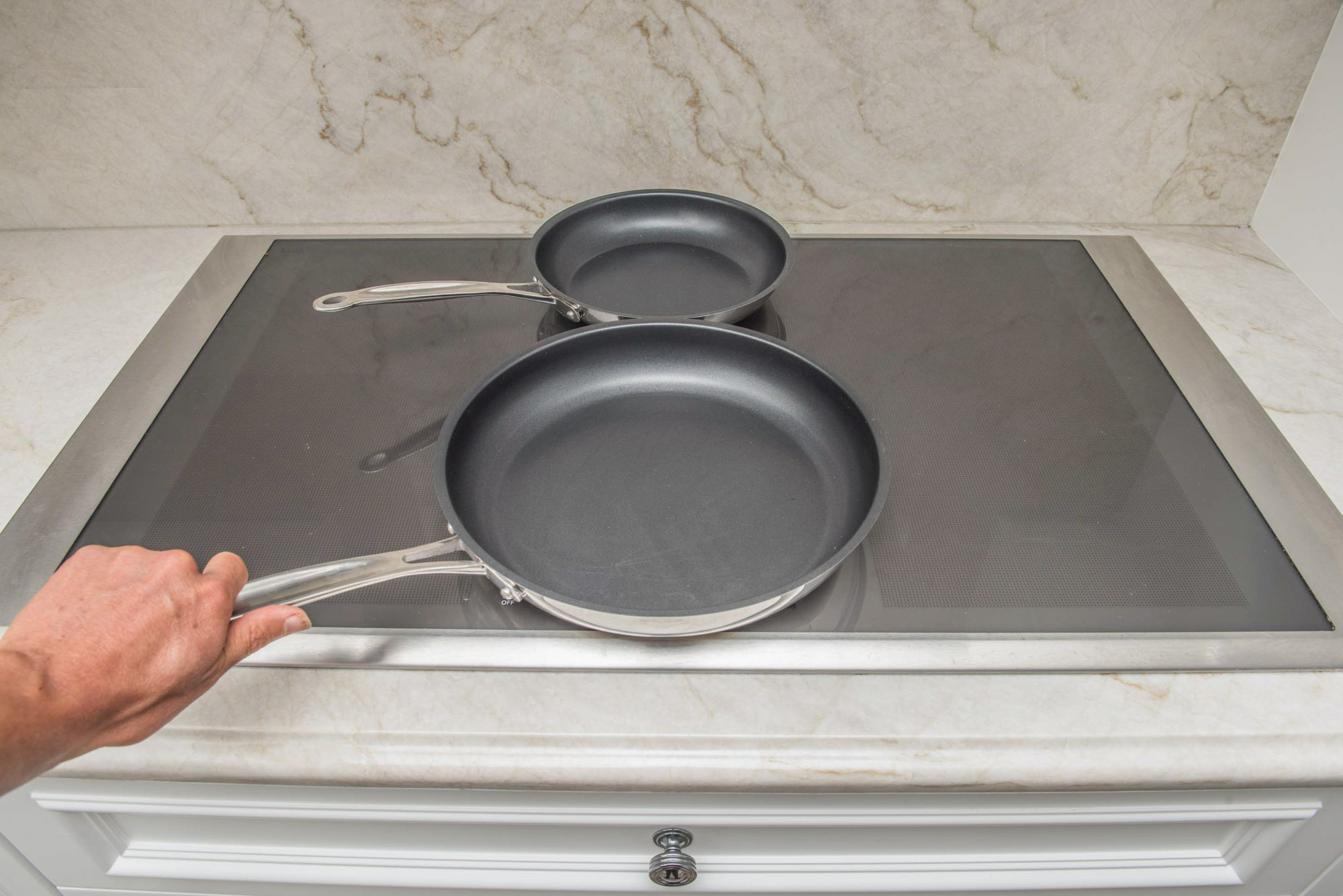
Cuisinart really stepped up their game with their Cuisinart – 722-911NS Chef’s Classic nonstick pan set. This high-end — but affordable — set includes a 9-inch skillet and an 11-inch skillet. Their stainless-steel, stay-cool handles are the appropriate length for the dimensions of the pans, which makes them both feel well balanced— unlike Anolon’s larger pan — and easy to maneuver.
The Cuisinart pans are triple-coated with a Teflon derivative called QuanTanium. Each QuanTanium layer is reinforced with titanium and ceramic particles, which Cuisinart claims give the pans maximum protection from wear and tear.
Visually, the Cuisinart – Chef’s Classic pans are stunners. Their glossy, mirror finish on the exterior has a professional look, and if you have the room for it, you would feel compelled to hang them over your stove.
Looks aren’t everything, of course, and the Cuisinart’s performance was on par with the Anolon. The pans’ conductivity and heat distribution weren’t quite as good as the Anolon, since it took nearly a minute for them to fully heat, and the flour browned quicker in the bottom two-thirds of the pan.
When we cracked the eggs into the center and upper third of the pan, however, they cooked exactly the same in a minute. The cooked eggs released onto a plate with just a gentle shake.
Pancakes browned evenly, and with some bravado, we flipped them up and over, just like you might see on a cooking show. The sole filet cooked perfectly and effortlessly released from the pan.
On the negative side, the Cuisinart pans have a slightly convex surface, so egg white dribbled down into the sides of each pan. Scrambled eggs also ran a bit into this gutter. However, though we had to move the eggs out of the sides, they cooked evenly and slid out onto a plate.
Cleaning was easy, and although the mirror glaze did not discolor from the high heat, we did notice a couple of slight spots on the bottom of the pan, which we scrubbed off. The Chef’s Classic pans are dishwasher safe, but Cuisinart does state that the pans will eventually lose their mirror finish with repeated dishwasher cleaning.
Cuisinart only sells the 9-inch and 11-inch pans as a set. The Chef’s Classic are so well-priced for such high-quality nonstick pans, you’re really getting two great pans for the price of one.
Key takeaways:
- With the glossy, mirror finish, the Cuisinart – Chef’s Classic pan set is not only beautiful but is completely nonstick as well.
- The skillets took longer to heat up than our top pick, but they performed just as well.
- The well-price set includes a 9-inch pan and an 11-inch pan, which you can’t buy separately.
Other nonstick pans we tested
All Clad – Fry Pan Set
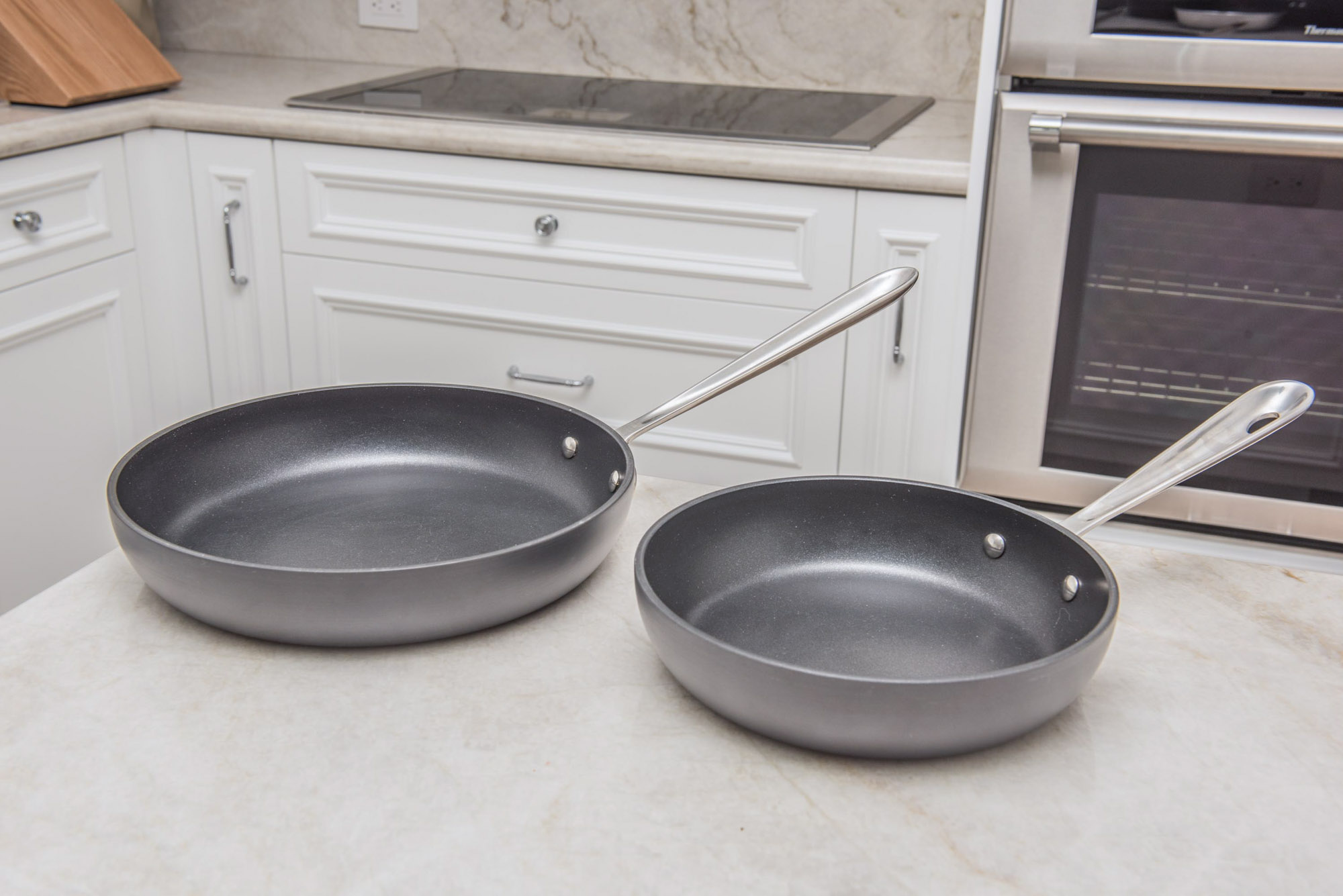
The All Clad – E785S264 nonstick pan set includes an 8-inch skillet and a 10-inch skillet. Both are similar in construction to the Anolon, but the All Clad pans are designed like classic saute pans: Low, straight sides and long handles. These features allow for searing meat and making pan sauces, but those tasks are more appropriate for a cast-iron skillet or stainless-steel pan.
The All Clad pans have convex surfaces, so the eggs and pancake batter ran into the side gutters and cooked too quickly. The pans’ nonstick coating was actually quite effective, however, and although the fish filet stuck slightly, it released without falling apart.
Both pans cleaned easily, but we did notice that food particles got stuck in between the pan and the rivets that connected the handle to the pan.
The All Clad is substantially more expensive than the Cuisinart set, which we believe to be better pans at a better price.
OXO Good Grips – Nonstick Pro
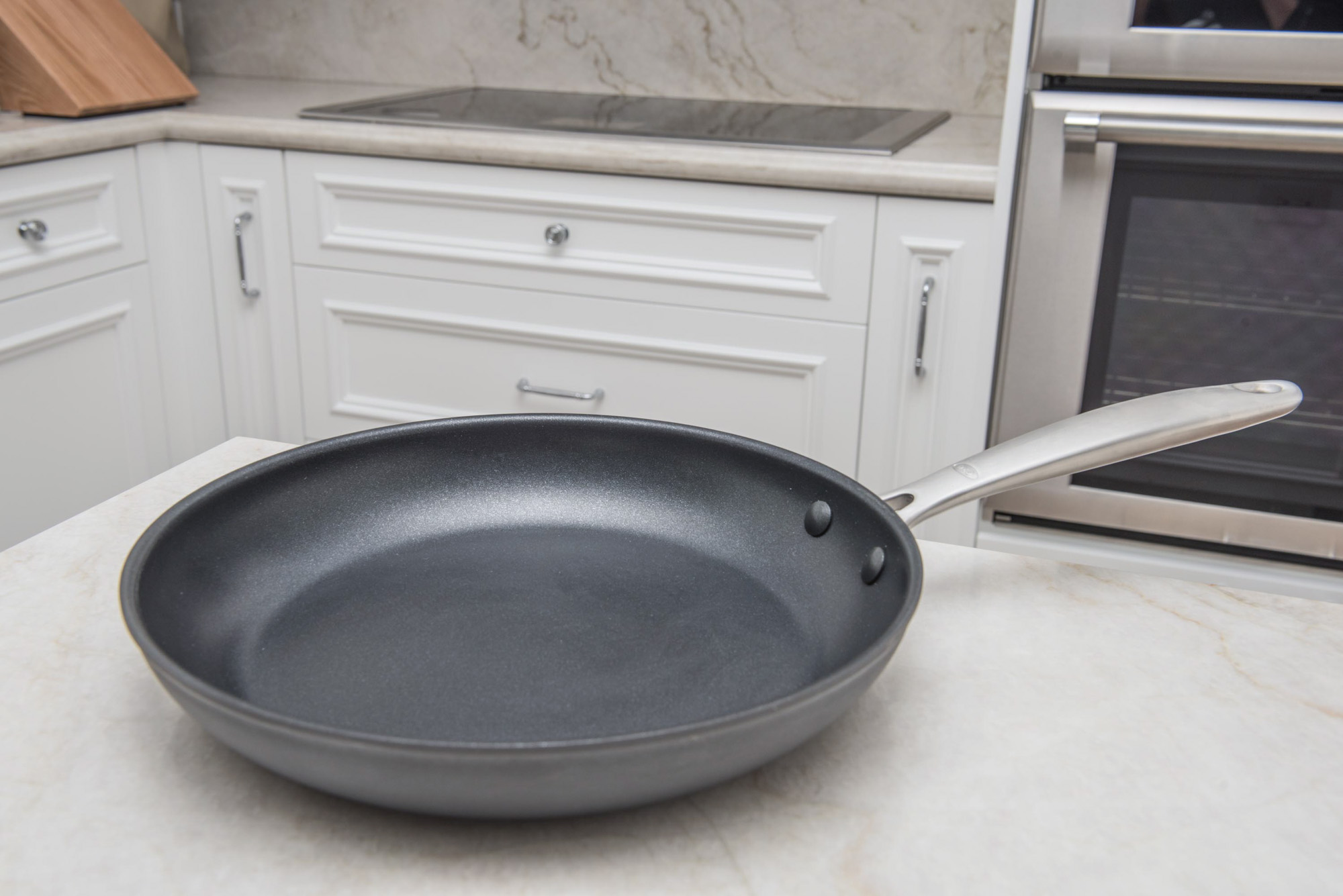
The OXO Good Grips – Nonstick Pro Fry Pan is a nicely constructed and well-balanced 10-inch skillet. It feels substantial in the hand yet also easy to maneuver. The stay-cool metal handle is contoured for a comfortable grip.
OXO markets their proprietary nonstick coating as German-engineered and PFOA-free. With some research, we learned that there are indeed German-engineered nonstick pans, and some may use ceramic or other non-PTFE materials, but OXO’s nonstick pans still have a Teflon-like coating.
OXO’s nonstick coating, however, isn’t really as effective as OXO makes it out to be. The pan’s heat distribution seemed off: The half closest to the handle was hotter than the opposite half. Everything cooked faster on the handle side so food stuck: It wasn’t a lot of sticking, but just enough that egg and fish wouldn’t release from the pan without prying them free.
OXO charges more for their kitchen tools and appliances, which are usually excellent. In this case, however we don’t feel that this nonstick pan’s performance merits its high price.
Calphalon – Classic Fry Pan
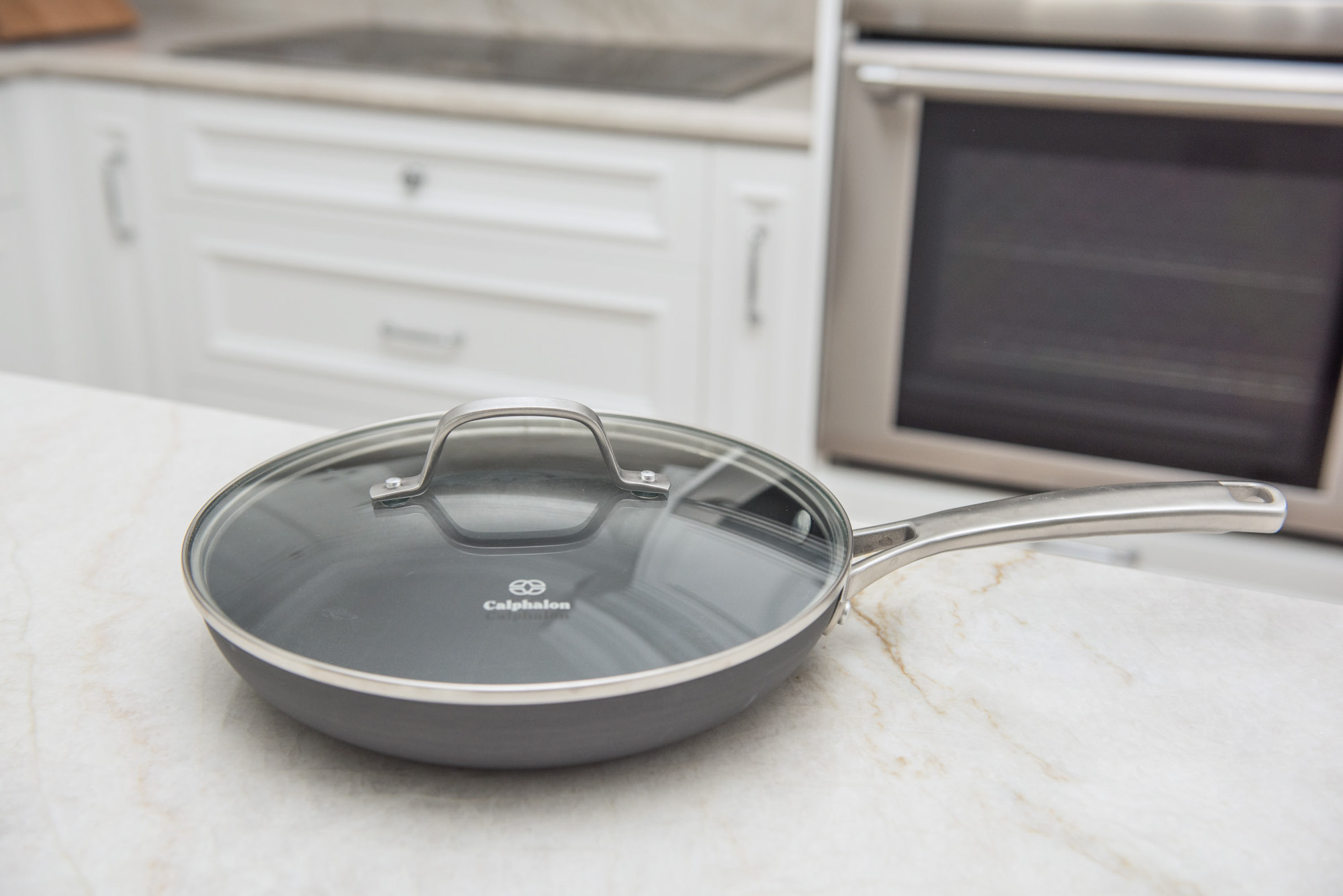
The Calphalon -1943286 Classic Fry Pan is a well-made, anodized aluminum 10-inch pan with a dual nonstick coating. All of the other pans we tested had three layers, and since Calphalon is perhaps one of the most recognized companies for nonstick cookware, it seems odd for this pan to have only two coatings. Calphalon makes its own nonstick coating, which is PTFE-based — basically, it’s Teflon — but it did not perform better than other similar coatings.
Heat distribution originated from the center of the pan and radiated outward, so everything we cooked on the edges browned less. The Calphalon took longer to heat up, but once it did, it was blistering hot, and food stuck. The pan has a stainless-steel handle, which should be cool, but the one-third of the handle connected to the pan was too hot to touch.
Circulon – Symmetry

The Circulon – 87507 Symmetry French Skillet set includes a 9-inch pan and an 11-inch pan. Both have a silicone-encased 8-inch handle, which is too short for the larger and substantially heavier pan.
Like all Circulon pans, the Symmetry French Skillet has raised circular ridges on its surface that the manufacturer claims help release food from the pan. However, in all of our tests, everything — except for the pancakes — stuck in between the ridges.
The Circulon had even heat induction and distribution, so the entire surface of the pan heated at the same time. We had success with the pancakes, which were easy to flip, but the fish stuck and fell apart when we tried to turn it. The circular ridges were most annoying with the fried and scrambled eggs, which got stuck between the grooves and browned too fast.
Cleaning was also a challenge. The sides of the pan wiped clean with a paper towel, but we had to scrape out the food bits trapped inside the ridges.
Tramontina – Professional Restaurant Fry Pan
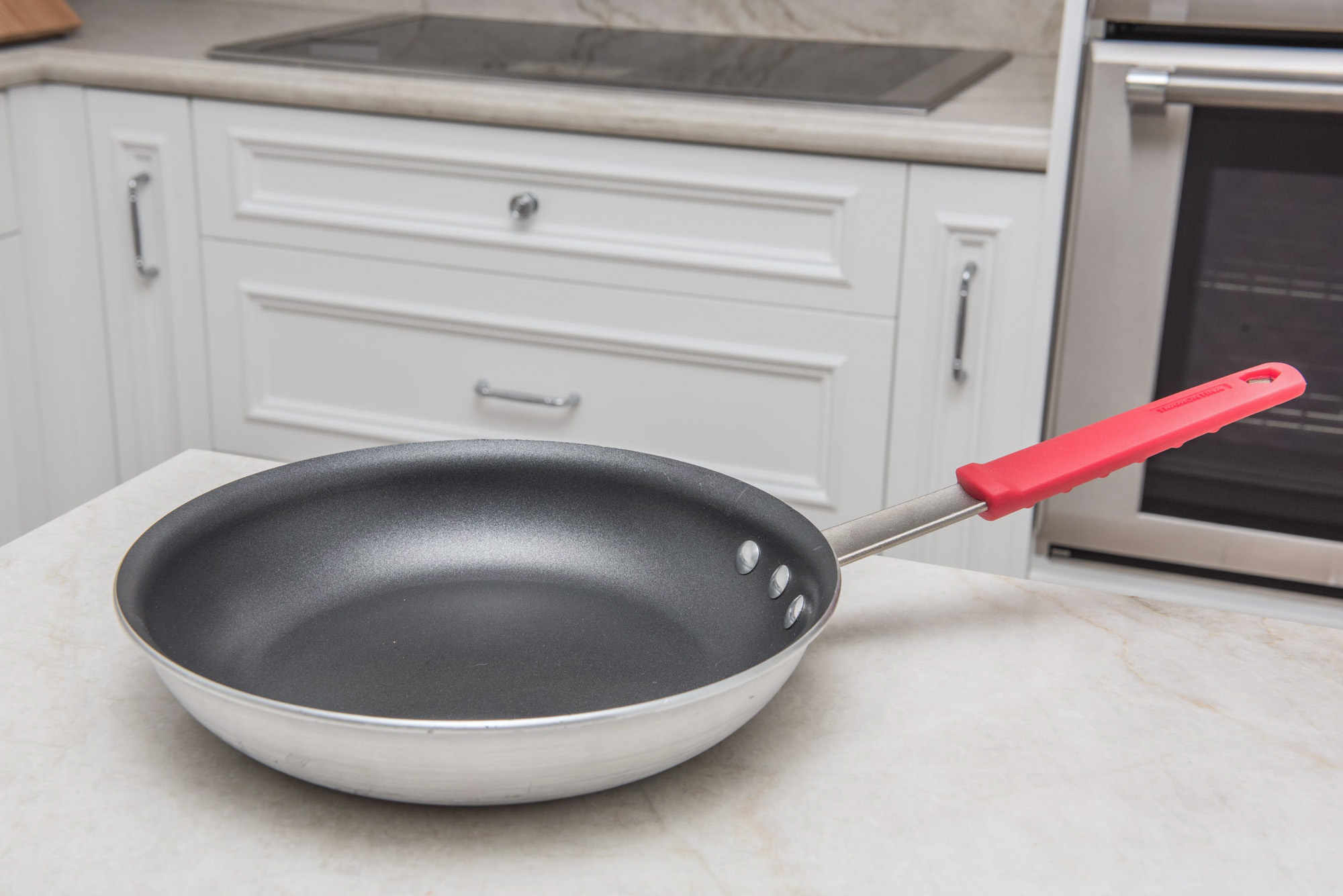
We were excited to try out the Tramontina 10-inch skillet, which was recommended by Wirecutter as the best nonstick pan. After testing the Tramontina, however, we were left scratching our heads wondering why Wirecutter praised it so highly.
It’s certainly a well-designed skillet, made of heavy-gauge aluminum and a long stainless-steel handle that’s further protected by a silicone sheath. At two pounds, however, the Tramontina was the heaviest of the 10-inch skillets we tested and difficult to maneuver.
Tramontina’s directions suggested massaging the pan with a little vegetable oil before cooking, but it didn’t do a thing; eggs, pancakes, fish and even the flour stuck.
It took somewhat more effort to clean the Tramontina, and the pretty-but-unprotected satin exterior finish on the bottom of the pan began to discolor during our test period. The Tramontina is reasonably priced, but its performance did nothing to win us over.
How we selected finalists to test
Nonstick pans are incredibly popular, but their composition and nonstick coating are controversial. Since nonstick pans are made of hardened aluminum and painted with several layers of nonstick coating, we read opinions and reviews that argued for and against using nonstick cookware.
To no one’s surprise, the majority of pro-nonstick websites we consulted are dedicated to cooking, such as Epicurious, Bon Appetit, The Food Network and Cook’s Illustrated. Their reviews of nonstick pans avoid entirely the health issues that are possibly linked to aluminum pans and nonstick coatings. In fact, they focus instead on the health benefits of using nonstick pans, because you don’t need to add oils and fats except as a flavoring.
Research into whether using nonstick pans is linked to health issues is ongoing. We did learn, however, of certain precautions you should take, which we followed during our testing.
We moved on to subreddits /r/cooking and /r/askculinary for opinions about the best nonstick pans and compared them to hundreds of Amazon reviews. We then culled together a list of the nonstick pans that were considered the best by experts and consumers alike. We had already reviewed the best nonstick cookware, so we turned our attention to 10-inch skillets, which most chefs agree are the right size and weight for cooking several eggs or pancakes at one time.
Because there are a variety of heating elements in today’s kitchens, we narrowed our selection to nonstick pans that are designed for use on gas, electric and induction cooktops. Not all of the nonstick pans we wanted to test are sold individually, so we also decided to test nonstick-pan sets that included a 10-inch skillet along with a smaller or larger pan.
Even properly cared for, nonstick coating doesn’t hold up longer than two years. There’s really no reason to spend a lot on a nonstick pan if you’re going to have to replace it. So we selected nonstick pans that were $40 or less.
How we tested
Heat distribution
We dusted flour over the bottom of each pan and turned the heat on low. As the flour browned we could tell how evenly the pan heated up. If the flour browned at the same time from center to edge, heat distribution was good. Only two of the finalists — the Anolon and the Circulon — browned the flour evenly. The other pans browned from the center and then radiated out to the edges or browned in spots.
Fried eggs
Most people who purchase a nonstick pan want to cook without oil. Because we wanted to test whether a pan’s coating was truly nonstick, we didn’t use oil in any of our cooking tests. Once the pan was heated, we cracked an egg in the center of the pan and another on the side furthest from the handle.
When the egg whites firmed up, we turned them over and noted any sticking. Finally, we attempted to shake the pan to release the eggs; if this failed, we gently eased the eggs out of the pan and again noted how much they stuck.
Scrambled eggs
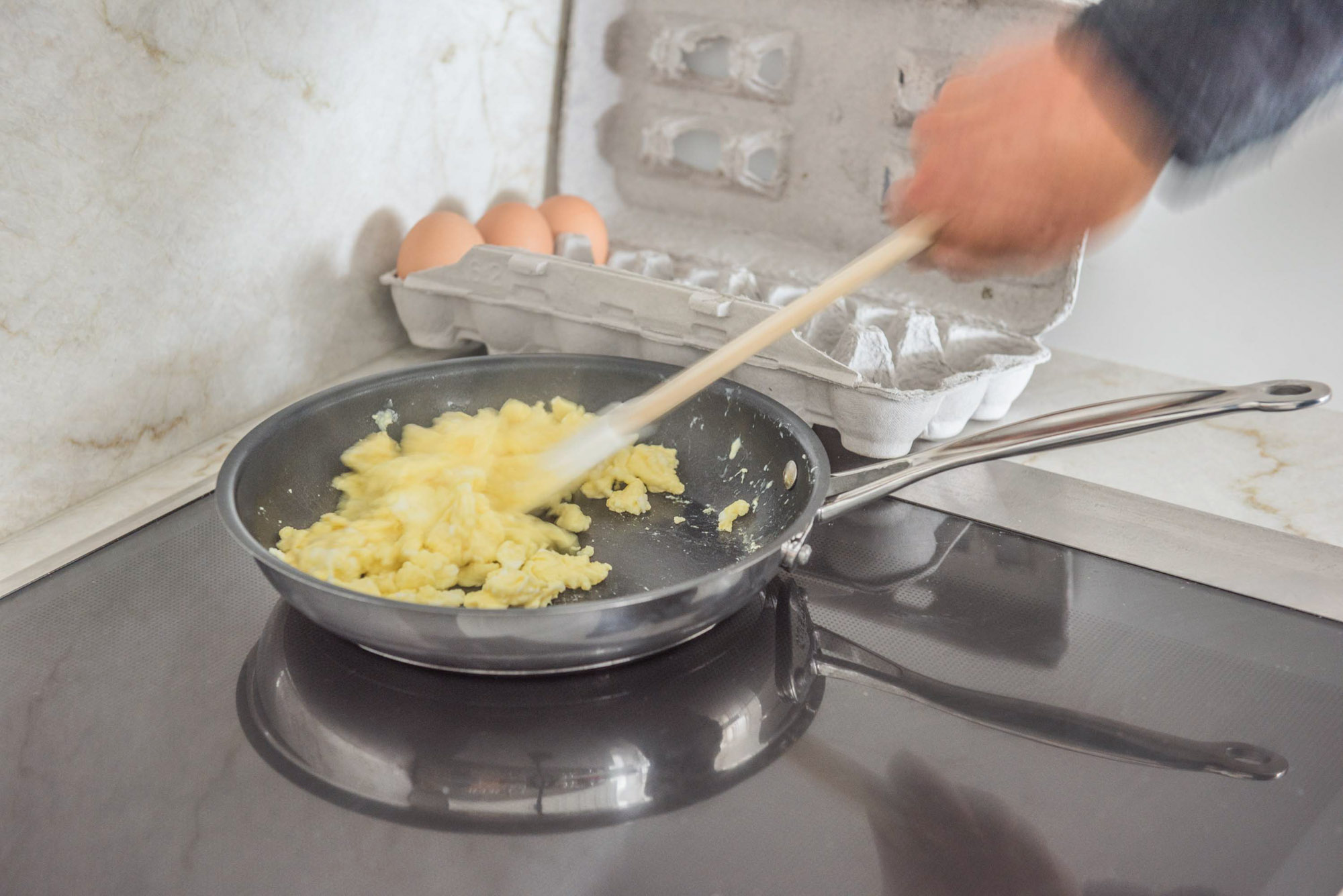
We whisked two eggs together and poured them into the pan. We immediately began moving them with a silicone spatula from the edges to the center. Because the eggs were in constant motion, most of the pans performed well. We had the most trouble with the Circulon, since the concentric circles trapped and browned the eggs between the ridges.
Pancakes
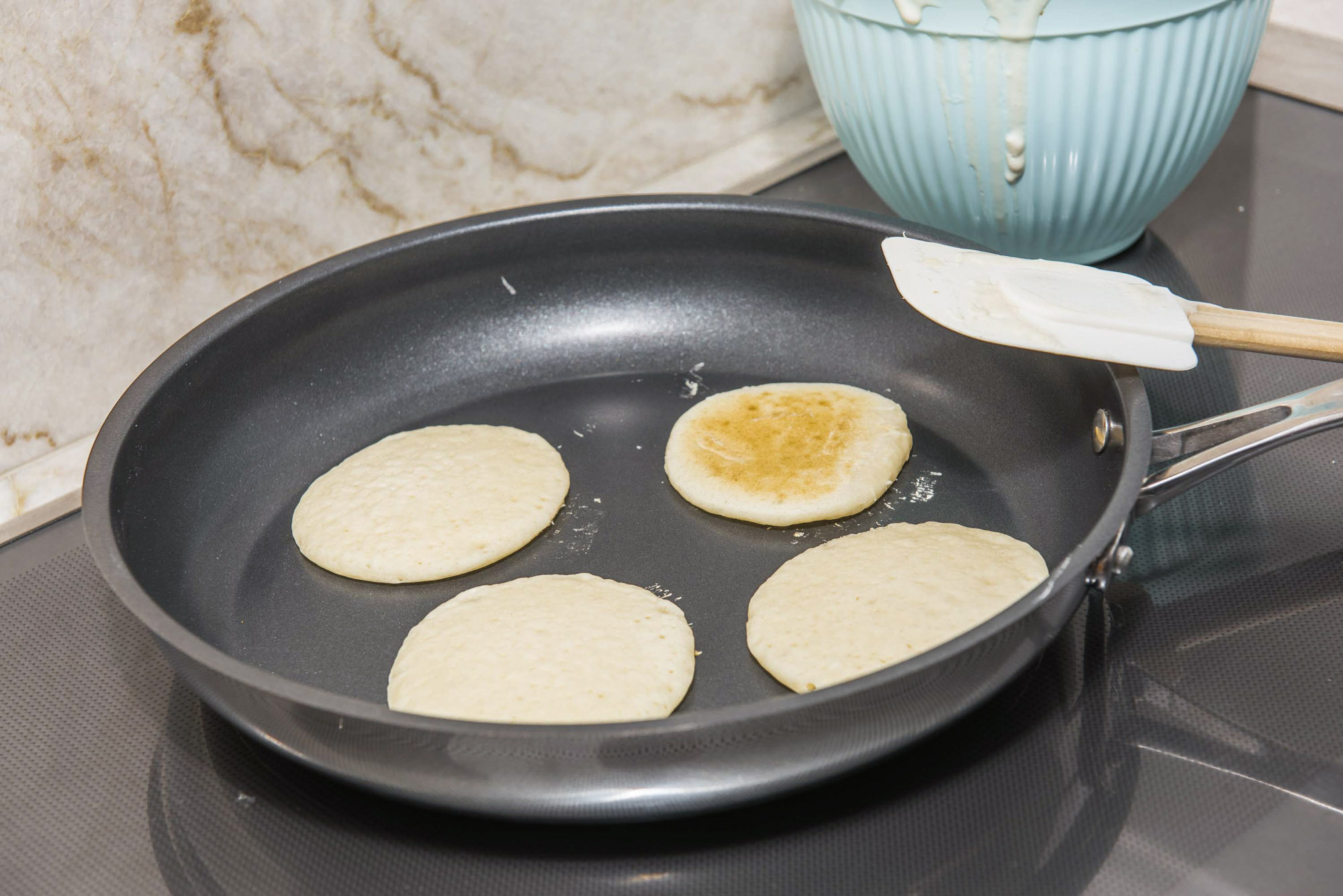
We used this basic recipe for pancakes and poured circles of batter into the pan: one in the center, one close to the handle and two on the opposite side of the handle. We noted whether the center pancake cooked faster than the pancakes near the handle and sides of the pan. We also attempted to flip the pancakes without using a spatula. Only if the pancake stuck did we use a silicone spatula to release them from the pan.
Filet of sole
We wanted a very delicate fish that could easily stick and fall apart. We put a thin three-ounce filet of sole into the pan for 30 seconds and then attempted to turn it over. This test proved to be the tell-all, as the fish stuck slightly or a lot to some pans and broke into pieces as we turned it over.
Two pans, however, were the clear champs: our top pick, the Anolon, and our top pick for a nonstick-pan set, the Cuisinart – Chef’s Classic. Both pans lightly browned the fish and were 100-percent nonstick. We turned the fish, and the filets were left intact.
Who needs a nonstick pan?
Nonstick pans have been in use since the 1950s, and if you’re a cook, it’s a pretty safe bet that you’ve cooked with one or two in your lifetime. If you’ve been using a nonstick pan for a while, it’s also quite likely that it looks like it’s been through a war; it’s scratched, peeling, warped, banged up and you need to slather it up with butter to keep food from sticking.
We’ve been using nonstick pans for many years, and we’ve been cooking everything, at all levels of heat, in them. Little did we know that a nonstick pan was not designed for cooking all kinds of food. How often have you preheated a nonstick pan on high and seared a ribeye or salmon steak? If you’re like us, countless times, and that’s a surefire way of diminishing the lifespan of a nonstick fry pan.
You’re actually quite limited as to what you can cook in a nonstick pan. Steaks, sautes, stir fries — anything that needs high heat — should be cooked in a cast-iron skillet or stainless-steel saute pan. With both of these pans you want stuff to stick, because those browned bits (also called fond ) can be whisked into a flavorful gravy or sauce.
Most nonstick pans are made from hardened aluminum, which has excellent heat conductivity, so they need less heat to cook food. Nonstick pans are thus ideal for delicate food that cooks quickly, such as:
- Fried eggs
- Scrambled eggs
- Omelettes
- Pancakes or crepes
- Delicate fish filets, such as sole or flounder
Every home cook should have at least one nonstick pan in the kitchen cabinet for this type of gentle, rapid cooking. If you’re looking to switch out your old pots and pans for new ones, our review of the best nonstick cookware includes saucepans, stock pots and saute pans.
What is nonstick coating?
Traditionally, nonstick coatings are made from polytetrafluoroethylene (PTFE), otherwise known as the famous (and infamous) brand name Teflon. It’s a paint that’s sprayed on the pan usually in three coats. The pan is then heat-cured to make sure the coating stays intact.
Perfluorooctanoic acid (PFOA) was a chemical commonly used for spraying the PTFE coats evenly. Although PFOA was initially deemed safe for home cooks using the pan, it did have harmful effects on the health of people working near or at the facility where the pan was manufactured and the PFOA applied.
In 2006, the U.S. Environmental Protection Agency linked perfluorinated compounds (PFCs) to a number of health issues, including cancer, and urged manufacturers to cease using PFOA by 2015. Since 2013, most companies have complied. All of the nonstick pans we tested were PFOA-free.
Is nonstick coating safe?
As we discussed in detail in our review of nonstick cookware about safety concerns, nonstick coatings can be harmful if the pan is improperly used. If an empty nonstick pan is left on an open flame long enough and heats to 662 ºF or higher, the PTFE begins to disintegrate. In those conditions, fine particles and noxious gasses are released and, if inhaled, can cause severe internal issues.
This off-gassing is particularly harmful — if not fatal — to birds, so many manufacturers now label packaging with a warning about using a nonstick pan in the vicinity of pet birds or parrots.
Nonstick coatings are generally considered safe if you follow these precautions:
Don’t preheat an empty pan: Most nonstick pans are made of heavy aluminum, which can hit the 662ºF danger point in a few minutes. Always have food or liquid in the pan, and keep it moving as it cooks.
Cook at medium or medium-low heat: Nonstick pans are designed to distribute heat evenly, so you don’t need to crank up the heat past medium for food to cook.
Ventilate your kitchen: Whether you use your stove’s ventilator or simply open a window, keep the air flowing while you cook. You could also run an air purifier, like the one we recommend in our best air purifier review, in your kitchen.
How to take care of a nonstick pan
Many complaints on Amazon about nonstick pans are that the nonstick coating scratches and flakes and stops working so that everything cooked sticks. People are also confused by the term “lifetime warranty” and try to return the pan a year after they purchased it.
Lifetime warranty is a vague term used by manufacturers to sell their product. It doesn’t mean that a nonstick pan will last the lifetime of the owner, nor does it refer to the pan’s lifetime, since that’s impossible to calculate.
A nonstick pan may hold up for 10 or 15 years, but the nonstick coating itself won’t last more than two years. There are a few best practices, however, you can follow that will help the nonstick coating last as long as possible.
Never use metal utensils with your nonstick cookware: Although several manufacturers claim their nonstick pan is scratch-proof, take it with a grain of salt. Only use wood or silicone utensils.
Don’t shock the pan in water: Any heavy-duty pan will warp from rapid change in temperature. After you’re done cooking, let the pan cool down before washing it.
Clean your pan with a scratch-proof pad or sponge: Nonstick coatings are sensitive to steel wool, scouring pads and abrasive powder. Instead, use a nonscratch sponge like the one we recommend in our review of the best kitchen cleaning sponges.
Wash and dry the pan by hand: Ignore the manufacturer’s claim that its nonstick pan is “dishwasher-safe.” Abrasive detergent powder and heat will damage the pan’s nonstick coating in no time. All of the nonstick pans we tested were easily wiped clean with a paper towel or damp sponge. Dry the pan by hand to keep rust from forming.
Never use an aerosol cooking spray: Cooking-oil sprays burn at a lower temperature than oil, and their burnt-on residue is almost impossible to remove without using a scouring pad.
Store your pans properly: Hang your pans, or store them in dividers in your cabinet. If you don’t have the space in your kitchen and need to stack your pans, line the interior and edges with microfiber cloths or paper towels.
Important features to consider
Flat, smooth surface: Some nonstick pans have a convex surface — a slight dome in the center — which allows the pan’s metal base to expand as it heats and prevents warping. One of the most common criticisms of nonstick pans is that convex surfaces cause runny foods, such as eggs or pancake batter, to dribble down the center of the pan and into the pan’s sides. So you want a pan that has a smooth, almost slick, surface and flat bottom, which sits evenly on your cooktop.
Size: Nonstick pans range in size from eight inches to 12.5 inches. If you want to cook an omelette or more than two eggs or pancakes at one time, we recommend a 10-inch pan. The 10-inch pan gives you enough room to flip eggs or pancakes. The larger pans certainly accommodate more food, but you’ll need a larger heating element to properly heat the entire pan.
Weight and grip: How much a pan should weigh and how you want it to fit in your hand are completely subjective choices. But we recommend that a pan should be light enough to flip an omelette or — if you’re skilled or daring — a sunny-side-up egg with a couple of quick flicks with your wrist. Almost all of the 10-inch pans we tested weighed under two pounds, which is light enough to easily maneuver the pan. The Tramontina was a few ounces heavier, and it was more difficult to move the pan around.
Shape: The best 10-inch nonstick pans are French skillets, which have a flat, smooth bottom and low, flared sides that give you easy access for flipping eggs, pancakes or fish.
Handle: A French skillet has a long handle that’s slightly shorter than the diameter of the pan. This length allows you to flip food with a quick jerking motion of your wrist and elbow. The handle should either have a silicone covering (Anolon Advanced) or be made of stainless steel (OXO Good Grips) to protect your hand from the intense heat generated by the pan.
Price: Some beautiful nonstick pans are available with high price tags; they’re not worth it. When the nonstick coating stops working (and it will), you’ll feel less pain replacing a $40 pan than you would an expensive one.
The bottom line
Competition is fierce for luring consumers to purchase pans that are purportedly “100-percent” or “totally” nonstick. We discovered from our testing, however, that many nonstick pans simply don’t work, unless you slather them with butter and oil, which completely defeats their purpose.
The best nonstick pan has a smooth, flat surface, a long handle either made from stainless steel or encased in silicone and even distribution of heat across the entire pan. The best nonstick pan, by far, is the Anolon Advanced.
In every test, everything we cooked on the Anolon Advanced was easily released by a simple shake of the pan, thanks to its high-quality nonstick coating. It has superb heat distribution to cook food evenly and quickly. The Anolon Advanced is dishwasher-safe, but it wipes clean in seconds with a paper towel or damp sponge, so there’s no need to risk damaging the pan’s nonstick coating in the dishwasher.
The best nonstick pan set is the Cuisinart – Chef’s Classic, which includes a 9-inch skillet and an 11-inch skillet. The pans have a beautiful mirror finish and look like chef’s pans you might see in a fancy restaurant. The Cuisinart pans were also perfectly nonstick and easy to clean. They’re very reasonably priced — we’d even say budget-priced — for such high-quality pans.
More Reviews
The 8 Best Electric Egg Cookers
Elite Gourmet - EGC-007B
The 8 Best Salt and Pepper Grinders
Merazi Living
Blue Apron
Martha & Marley Spoon
HelloFresh Meal Delivery Kit Review
HelloFresh
Brita - Monterey with Longlast Filter
OXO - Barista Brain
Balls of Steel



